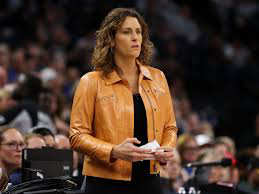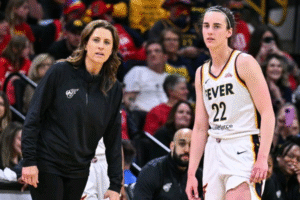
Indiana Fever’s Momentum Crumbles After Commissioner’s Cup Triumph: Caitlin Clark and Team Seek Urgent Reset
After their triumphant win in the 2025 Commissioner’s Cup, the Indiana Fever seemed to be riding high. Their emphatic victory over the reigning champions sent a strong message to the rest of the league, proving they could hold their own against the WNBA’s best. The Fever not only dismantled one of the league’s elite teams but also delivered a decisive 15-point win, momentarily silencing critics who had questioned their legitimacy as contenders.

But what appeared to be a season-defining moment quickly morphed into a turning point of stagnation. Rather than using the victory as a springboard to maintain their intensity, the Fever appeared to settle into a comfort zone. The hunger and energy that had fueled their Cup run were noticeably absent in the following matchups.
Their narrow two-point defeat to the Los Angeles Sparks was particularly disheartening. It wasn’t just about the final score—it reflected a deeper lack of urgency and sharpness. Still, fans hoped that the return of star guard Caitlin Clark to the active lineup would reignite the team’s spark. Clark, fresh off her Rookie of the Year win in 2024, was expected to bring firepower and leadership back to the squad. Unfortunately, her presence didn’t have the intended effect.
Instead, things took an alarming turn when the Fever faced off against the Golden State Valkyries. Anticipation was high, but the matchup quickly devolved into what many are calling the Fever’s most disappointing outing of the season. From the first quarter, it was clear the team lacked rhythm and confidence. Clark, who typically sets the tone, fell hard to the floor early in the game—a moment that seemed to foreshadow the team’s unraveling.
Despite narrowly winning the first quarter 23-21, the Fever failed to capitalize on that momentum. The Valkyries responded with overwhelming intensity, methodically dismantling Indiana’s game plan. Indiana’s defense faltered, offensive possessions became disjointed, and Golden State widened the gap quarter after quarter. The game ended in a lopsided 80-61 defeat for Indiana—marking their second-lowest scoring performance of the season.
Caitlin Clark, clearly disappointed, faced the media after the game and accepted full responsibility for the team’s collapse. In a candid post-game interview, she acknowledged her underwhelming play and emphasized accountability. However, Head Coach Stephanie White wasn’t ready to let the team off the hook with a simple apology.
Coach White, aiming for long-term success and a potential title run, wasted no time signaling that changes were coming. According to Moreau Sports Media, who shared the update on social platform X (formerly Twitter), White is implementing major strategic adjustments to get the team back on track. In her post-game comments, she explained that the Fever would begin experimenting with dual primary ball handlers—a significant departure from their current strategy centered around Clark’s playmaking.
“I like the ability to have two primaries on the floor,” White said, “It allows us to give our opponents different looks. And quite frankly, it helps Caitlin. She won’t have to bring the ball up under pressure for 94 feet every possession.”
This tactical pivot is both surprising and telling. Clark has consistently served as the Fever’s lead ball handler, orchestrating plays and initiating offense. As the centerpiece of Indiana’s game plan, her ability to create scoring opportunities—whether for herself or her teammates—has been crucial. But against Golden State, she struggled to make an impact. Clark went just 4-of-12 from the floor, tallying 10 points, six assists, and five rebounds in 25 minutes. Her numbers, while not disastrous, didn’t reflect the kind of dominance she’s capable of or the leadership expected from her.
The proposed shift to an off-ball role aims to unlock new dimensions in both Clark’s game and the team’s offense. By freeing her from relentless defensive pressure at the top of the key, the Fever can utilize her elite shooting and court vision in other ways—coming off screens, spacing the floor, or cutting to the basket. The move could also allow other guards to handle primary playmaking duties, giving the offense more variety and unpredictability.
Coach White had hinted at this approach even before the Valkyries game. In a pre-game press conference, she outlined the potential benefits of using Clark in off-ball situations. “Whether she’s in the action or simply spacing out wide, Caitlin draws attention,” White noted. “Defenses are always focused on her, so by moving her around, we create openings for others.”
This evolution in offensive philosophy could lead to a more dynamic and balanced team. Still, it’s a gamble—especially for a franchise whose entire system has been built around Clark’s on-ball brilliance. The announcement has generated a strong reaction among fans and analysts, many of whom were caught off guard by the move. After all, Clark’s historic college career and immediate impact in the WNBA were largely due to her ability to control the tempo and dictate plays from the point guard position.
Despite the skepticism, White appears resolute in her belief that this change is necessary. The Fever’s recent slump has made it clear that relying solely on Clark to carry the team isn’t sustainable. Opposing teams have begun to key in on her tendencies, applying full-court pressure and forcing her into difficult situations. Giving her a break from the relentless physical toll of ball-handling duties might be the reset she needs to return to peak performance.
Meanwhile, Clark’s willingness to take accountability speaks to her maturity and leadership. In post-game interviews, she made no excuses, acknowledging that the loss to the Valkyries fell largely on her shoulders. That level of ownership is rare for a player in just her second year and signals that she’s ready to embrace whatever role the team needs from her.
Still, the question remains: can the Fever right the ship before their season slips away entirely? Their Commissioner’s Cup victory proved they’re capable of competing with top-tier teams. But since then, their fire has dimmed, and their cohesion has weakened. The dual-ball-handler strategy might be the antidote to their offensive stagnation—but only if the players fully buy in and execute the game plan with precision.
As for Clark, this adjustment period could become a defining chapter in her young career. Great players aren’t just measured by their stats but by their ability to adapt, evolve, and lead their teams through adversity. If she can successfully transition into a more flexible role, she may unlock new levels of effectiveness—and help Indiana become a more complete and dangerous team in the process.
Moving forward, fans and analysts alike will closely monitor how the Fever respond. Their next few games will be critical—not just in the standings, but in determining the identity of the team. Will they remain overly reliant on one star? Or will they discover new weapons, build chemistry, and re-emerge as true title contenders?
One thing is certain: the road ahead for Indiana won’t be easy. But with decisive leadership from Coach White, a maturing superstar in Clark, and a willingness to evolve, the Fever still have the tools to turn things around. The talent is there. The question now is whether the hunger returns.
Leave a Reply